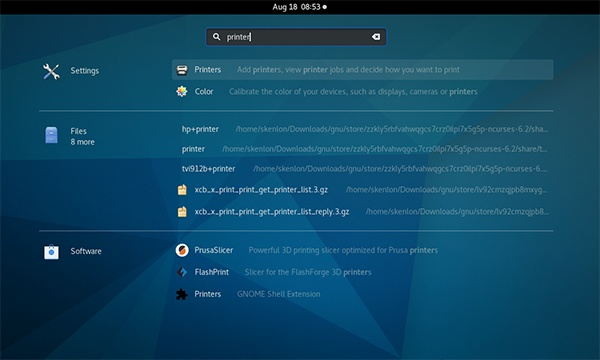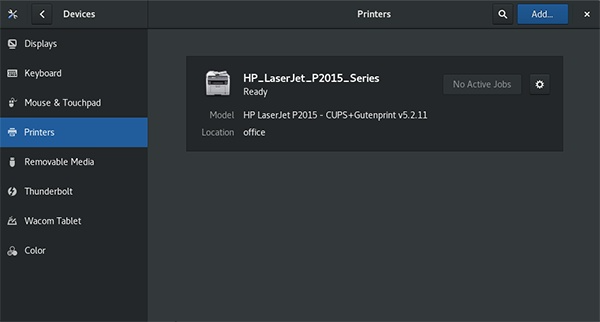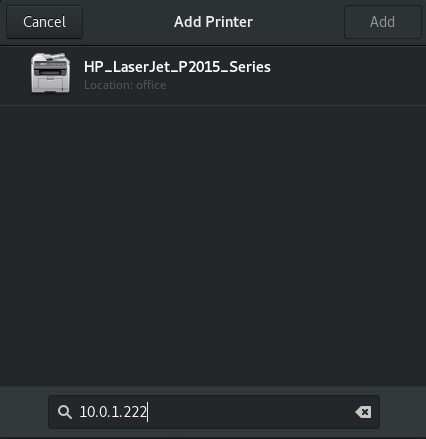 System Tutorial
System Tutorial
 LINUX
LINUX
 The interconnection of the printing world - research on printing technology under Linux system
The interconnection of the printing world - research on printing technology under Linux system
The interconnection of the printing world - research on printing technology under Linux system
In modern society, printing technology has become an indispensable part. In the rapidly developing digital era, printing technology under Linux system is particularly important. This article will conduct a series of studies on printing technology under Linux systems and explore how to achieve efficient, stable, and secure printing services under Linux systems.
If your printer is not automatically detected by the system, you can find out how to manually add a printer on Linux in this article. This article assumes you are using the GNOME graphical desktop system, and the setup process also applies to KDE or most other desktop systems.
Printer driver
When you try to print files with a printer, first confirm whether the updated printer driver has been installed on your Linux system.
There are three major categories of printer drivers you can try to install:
- The open source Gutenprint driver provided as an installation package bundled with your Linux system
- Special driver provided by printer manufacturer
- Printer driver provided by third-party development
The open source printer driver library can drive more than 700 printers and is worth installing. There may be a driver for your printer in it, and it may be able to automatically set up your printer (so you can use it) .
Install open source driver package (library)
Some Linux distributions have pre-installed open source printer driver packages. If not, you can use the package manager to install it. For example, on Linux systems with Fedora, CentOS, Magela and other similar distributions, execute the following command to install:
$ sudo dnf install gutenprint
HP series printers also need to install HP’s Linux Graphics and Printing System Package (HPLIP). For example, on Debian, Linux Mint and other similar systems, you can use the following command:
$ sudo apt install hplip
Install the driver provided by the manufacturer
Many times because printer manufacturers use non-standard interface protocols, in this case the open source printer driver cannot drive the printer. In other cases, open source drivers can make the printer work, but will lack some vendor-specific features. In these cases, you need to visit the manufacturer's website to find the Linux platform driver for your printer model. The installation process varies, read the installation guide carefully to install step by step.
If your printer is not supported by the manufacturer at all, you may have to try the driver software for this model of printer provided by a third party. Such third-party drivers are not open source, but neither are the proprietary drivers for most printers. If you need to spend extra money to get help from the supplier to install the driver and use your printer, that is very distressing, or you simply throw away the printer, at least you know that you will never buy this brand again next time Printer.
Universal Print Driver System (CUPS)
Common Unix Printing System (CUPS) was developed by Easy Software Products in 1997 and acquired by Apple in 2007. This is the open source base software package for printing on the Linux platform, and most modern distributions provide a customized interface for it. Thanks to CUPS technology, you can discover printers connected to your computer via USB or even shared printers connected to the same network.
Once you have installed the required driver packages, you can add your printer manually. First, connect the printer to a running computer and turn on the printer power. Then find and open Printers settings from the Activity screen or app list.

printer settings
Based on the driver package you have installed, your Linux system may automatically detect and recognize your printer model, and you can use your printer without additional settings.

printer settings
Once you find your printer model in the list, set it up to use this driver, and congratulations, you can print with it on your Linux system.
(If your printer is not automatically recognized,) you need to add the printer yourself. In the "Printer" setting interface, click the unlock button in the upper right corner, enter the administrative user password, and the button will transform into an "Add Printer" button.
Then click the "Add Printer" button, and the computer will search for the connected local printer model and match the corresponding driver. If you want to add a network shared printer, enter the IP address of the printer or its server machine in the search box.

searching for a printer
Select the printer model you want to add, click the "Add" button to add the printer driver to the system, and then you can use it.
Printing on Linux systems
Printing on a Linux system is easy, whether you are using a local or network printer. If you plan to buy a printer, it is recommended to check the Open Printing Technology Organization's (supported printers) database (OpenPrinting.org) to see if the printer you want to buy has a corresponding open source driver. If you already own a printer, you now know how to use your printer on your Linux system.
Through the exploration and experiments in this article, we can see that it is not difficult to implement efficient, stable, and secure printing services under Linux systems. You can use CUPS as the core of print service support. You can choose to use other protocols such as lpd or samba during specific configuration. At the same time, you need to pay attention to the security issues of the printer device. In the days to come, we will see printing technology under Linux systems being continuously optimized and improved, making the connection between the printing world and the digital world closer.
The above is the detailed content of The interconnection of the printing world - research on printing technology under Linux system. For more information, please follow other related articles on the PHP Chinese website!

Hot AI Tools

Undresser.AI Undress
AI-powered app for creating realistic nude photos

AI Clothes Remover
Online AI tool for removing clothes from photos.

Undress AI Tool
Undress images for free

Clothoff.io
AI clothes remover

Video Face Swap
Swap faces in any video effortlessly with our completely free AI face swap tool!

Hot Article

Hot Tools

Notepad++7.3.1
Easy-to-use and free code editor

SublimeText3 Chinese version
Chinese version, very easy to use

Zend Studio 13.0.1
Powerful PHP integrated development environment

Dreamweaver CS6
Visual web development tools

SublimeText3 Mac version
God-level code editing software (SublimeText3)

Hot Topics
 What computer configuration is required for vscode
Apr 15, 2025 pm 09:48 PM
What computer configuration is required for vscode
Apr 15, 2025 pm 09:48 PM
VS Code system requirements: Operating system: Windows 10 and above, macOS 10.12 and above, Linux distribution processor: minimum 1.6 GHz, recommended 2.0 GHz and above memory: minimum 512 MB, recommended 4 GB and above storage space: minimum 250 MB, recommended 1 GB and above other requirements: stable network connection, Xorg/Wayland (Linux)
 Linux Architecture: Unveiling the 5 Basic Components
Apr 20, 2025 am 12:04 AM
Linux Architecture: Unveiling the 5 Basic Components
Apr 20, 2025 am 12:04 AM
The five basic components of the Linux system are: 1. Kernel, 2. System library, 3. System utilities, 4. Graphical user interface, 5. Applications. The kernel manages hardware resources, the system library provides precompiled functions, system utilities are used for system management, the GUI provides visual interaction, and applications use these components to implement functions.
 vscode terminal usage tutorial
Apr 15, 2025 pm 10:09 PM
vscode terminal usage tutorial
Apr 15, 2025 pm 10:09 PM
vscode built-in terminal is a development tool that allows running commands and scripts within the editor to simplify the development process. How to use vscode terminal: Open the terminal with the shortcut key (Ctrl/Cmd). Enter a command or run the script. Use hotkeys (such as Ctrl L to clear the terminal). Change the working directory (such as the cd command). Advanced features include debug mode, automatic code snippet completion, and interactive command history.
 How to check the warehouse address of git
Apr 17, 2025 pm 01:54 PM
How to check the warehouse address of git
Apr 17, 2025 pm 01:54 PM
To view the Git repository address, perform the following steps: 1. Open the command line and navigate to the repository directory; 2. Run the "git remote -v" command; 3. View the repository name in the output and its corresponding address.
 How to run java code in notepad
Apr 16, 2025 pm 07:39 PM
How to run java code in notepad
Apr 16, 2025 pm 07:39 PM
Although Notepad cannot run Java code directly, it can be achieved by using other tools: using the command line compiler (javac) to generate a bytecode file (filename.class). Use the Java interpreter (java) to interpret bytecode, execute the code, and output the result.
 Where to write code in vscode
Apr 15, 2025 pm 09:54 PM
Where to write code in vscode
Apr 15, 2025 pm 09:54 PM
Writing code in Visual Studio Code (VSCode) is simple and easy to use. Just install VSCode, create a project, select a language, create a file, write code, save and run it. The advantages of VSCode include cross-platform, free and open source, powerful features, rich extensions, and lightweight and fast.
 What is the main purpose of Linux?
Apr 16, 2025 am 12:19 AM
What is the main purpose of Linux?
Apr 16, 2025 am 12:19 AM
The main uses of Linux include: 1. Server operating system, 2. Embedded system, 3. Desktop operating system, 4. Development and testing environment. Linux excels in these areas, providing stability, security and efficient development tools.
 How to run sublime after writing the code
Apr 16, 2025 am 08:51 AM
How to run sublime after writing the code
Apr 16, 2025 am 08:51 AM
There are six ways to run code in Sublime: through hotkeys, menus, build systems, command lines, set default build systems, and custom build commands, and run individual files/projects by right-clicking on projects/files. The build system availability depends on the installation of Sublime Text.





